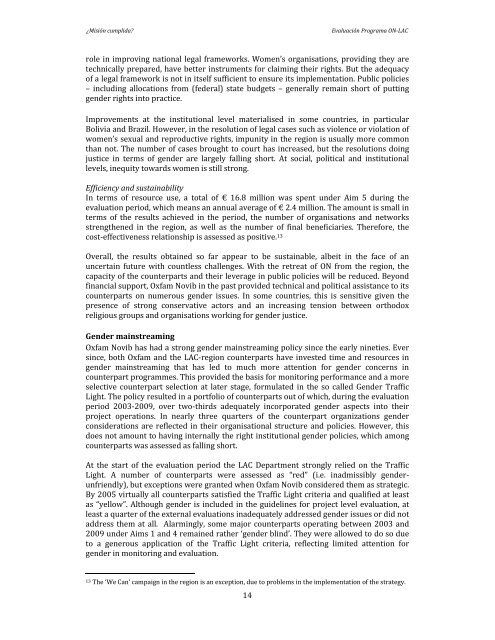¿MISION CUMPLIDA? EVALUACIÓN DEL PROGRAMA DE ... - Novib
¿MISION CUMPLIDA? EVALUACIÓN DEL PROGRAMA DE ... - Novib
¿MISION CUMPLIDA? EVALUACIÓN DEL PROGRAMA DE ... - Novib
Create successful ePaper yourself
Turn your PDF publications into a flip-book with our unique Google optimized e-Paper software.
¿Misión cumplida? Evaluación Programa ON-LAC<br />
role in improving national legal frameworks. Women’s organisations, providing they are<br />
technically prepared, have better instruments for claiming their rights. But the adequacy<br />
of a legal framework is not in itself sufficient to ensure its implementation. Public policies<br />
– including allocations from (federal) state budgets – generally remain short of putting<br />
gender rights into practice.<br />
Improvements at the institutional level materialised in some countries, in particular<br />
Bolivia and Brazil. However, in the resolution of legal cases such as violence or violation of<br />
women’s sexual and reproductive rights, impunity in the region is usually more common<br />
than not. The number of cases brought to court has increased, but the resolutions doing<br />
justice in terms of gender are largely falling short. At social, political and institutional<br />
levels, inequity towards women is still strong.<br />
Efficiency and sustainability<br />
In terms of resource use, a total of € 16.8 million was spent under Aim 5 during the<br />
evaluation period, which means an annual average of € 2.4 million. The amount is small in<br />
terms of the results achieved in the period, the number of organisations and networks<br />
strengthened in the region, as well as the number of final beneficiaries. Therefore, the<br />
cost-effectiveness relationship is assessed as positive. 13<br />
Overall, the results obtained so far appear to be sustainable, albeit in the face of an<br />
uncertain future with countless challenges. With the retreat of ON from the region, the<br />
capacity of the counterparts and their leverage in public policies will be reduced. Beyond<br />
financial support, Oxfam <strong>Novib</strong> in the past provided technical and political assistance to its<br />
counterparts on numerous gender issues. In some countries, this is sensitive given the<br />
presence of strong conservative actors and an increasing tension between orthodox<br />
religious groups and organisations working for gender justice.<br />
Gender mainstreaming<br />
Oxfam <strong>Novib</strong> has had a strong gender mainstreaming policy since the early nineties. Ever<br />
since, both Oxfam and the LAC-region counterparts have invested time and resources in<br />
gender mainstreaming that has led to much more attention for gender concerns in<br />
counterpart programmes. This provided the basis for monitoring performance and a more<br />
selective counterpart selection at later stage, formulated in the so called Gender Traffic<br />
Light. The policy resulted in a portfolio of counterparts out of which, during the evaluation<br />
period 2003-2009, over two-thirds adequately incorporated gender aspects into their<br />
project operations. In nearly three quarters of the counterpart organizations gender<br />
considerations are reflected in their organisational structure and policies. However, this<br />
does not amount to having internally the right institutional gender policies, which among<br />
counterparts was assessed as falling short.<br />
At the start of the evaluation period the LAC Department strongly relied on the Traffic<br />
Light. A number of counterparts were assessed as “red” (i.e. inadmissibly genderunfriendly),<br />
but exceptions were granted when Oxfam <strong>Novib</strong> considered them as strategic.<br />
By 2005 virtually all counterparts satisfied the Traffic Light criteria and qualified at least<br />
as “yellow”. Although gender is included in the guidelines for project level evaluation, at<br />
least a quarter of the external evaluations inadequately addressed gender issues or did not<br />
address them at all. Alarmingly, some major counterparts operating between 2003 and<br />
2009 under Aims 1 and 4 remained rather ‘gender blind’. They were allowed to do so due<br />
to a generous application of the Traffic Light criteria, reflecting limited attention for<br />
gender in monitoring and evaluation.<br />
13 The ‘We Can’ campaign in the region is an exception, due to problems in the implementation of the strategy.<br />
14



